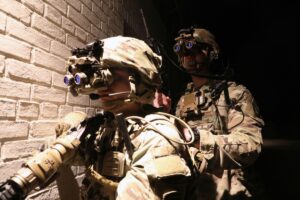The Senate Armed Services Committee added $75 million in its version of the next defense policy bill for Army procurement for the Enhanced Night Vision Goggle-Binocular (ENVG-B), after the service had requested no funding for the program in its fiscal year 2023 budget request.
The bill report accompanying SASC’s FY ‘23 National Defense Authorization Act (NDAA), released on Monday evening, calls for the Army to brief the panel on its night vision strategy and how the service is balancing priorities for ENVG-B along with the new Integrated Visual Augmentation System (IVAS) headset.

“The committee is concerned about the Army’s decision to terminate procurement of the ENVG-B before the IVAS is fully certified to meet operational requirements. This decision creates risk for soldiers and, according to the Army’s own unfunded priority list, will decrease soldier survivability,” SASC writes.
The ENVG-B procurement plus-up follows a SASC hearing from early May where Sen. Jeanne Shaheen (D-N.H.) pressed Army Secretary Christine Wormuth on the decision to include funding for the new night vision goggles in the budget request (Defense Daily, May 5).
“I’m concerned that this decision not only harms our soldiers by limiting access to more advanced night vision systems but also affects our nation’s already limited night vision manufacturing industrial base,” Shaheen said at the time.
Wormuth then responded that Army leadership concluded it had procured the number of night vision goggles “that we thought would meet our requirements.”
ENVG-B was included on the Army’s $5.1 billion unfunded priorities list for FY ‘22, with Shaheen having noted the document states that “a lack of funding decreases soldier’s survivability” and “places the manufacturer at risk of closing the production line.”
L3Harris [LHX], which produces the system in Shaheen’s home state, and Elbit Systems of America each received production deals from the Army in October 2020 worth potentially $442 million to deliver ENVG-B devices to begin replacing its legacy monocular night vision devices (Defense Daily, Oct. 22 2020).
“Additionally, the committee is concerned that halting ENVG-B production disrupts the supporting supply chains. The committee is concerned that the Army is not taking into consideration the long-term industrial base consequences of their decision and assuming unnecessary risk,” the committee writes in its bill report.
SASC’s NDAA includes a provision directing the Army to brief the Armed Services Committees by the end of next January on “the Army’s plan to ensure soldiers continue to have access to next-generation night vision systems and to sustain the night vision manufacturing industrial base.”
The committee’s version of the bill authorizes a total of $499.3 million for the Army’s night vision devices account, which would support the Army’s requested plans for IVAS spending to procure over 7,000 of the Microsoft [MSFT]-built headsets.
House appropriators have moved to cut $400 million for IVAS procurement from its version of the FY ‘23 defense spending bill, withholding the funds while the service waits to conclude its operational evaluation of the new headset (Defense Daily, June 21).
“With questions still outstanding regarding the production viability of IVAS, the committee cannot recommend additional procurement funding until after a full review of the results of [initial operational test and evaluation] (IOT&E),” lawmakers wrote in a report accompanying the House Appropriations Committee’s defense spending bill.
Doug Bush, the Army’s top acquisition official, told Defense Daily last week early analysis of data collected from the IOT&E for IVAS is showing “positive signs” of improvements with the capability (Defense Daily, June 12).
SASC filed its FY ‘23 NDAA for full Senate consideration on Tuesday, which follows the committee’s 23 to 3 vote in June to advance its $847 billion version of the bill (Defense Daily, June 16).